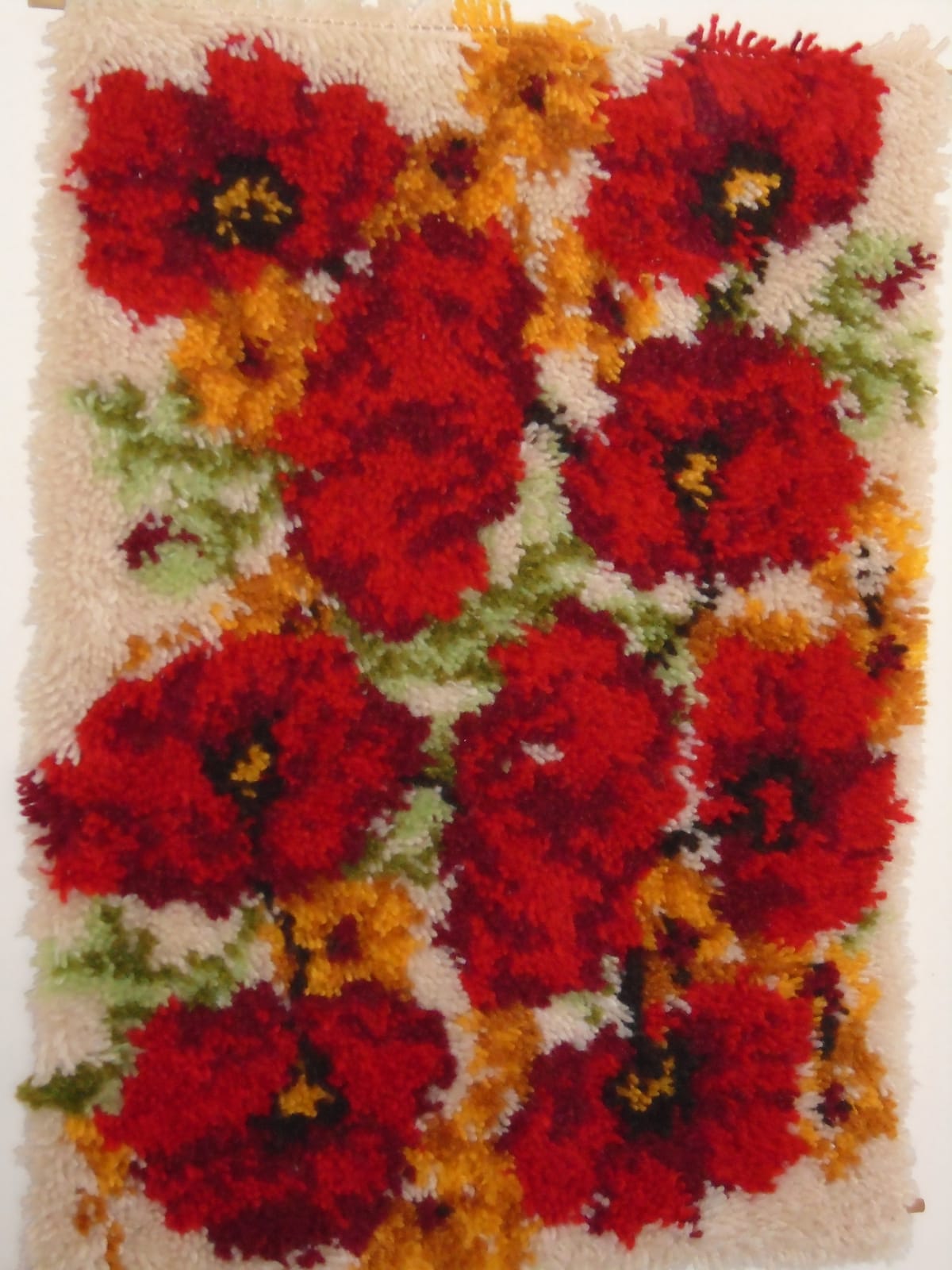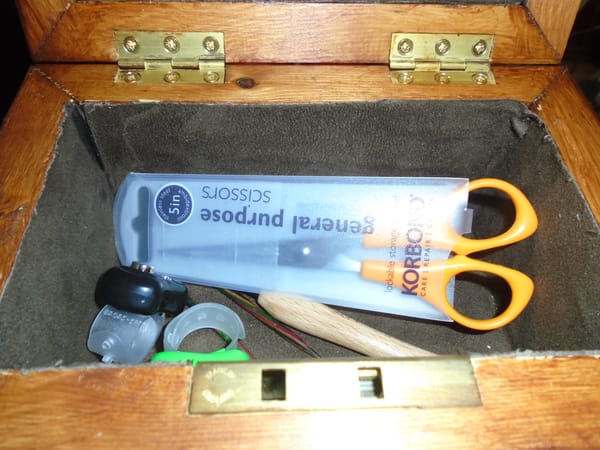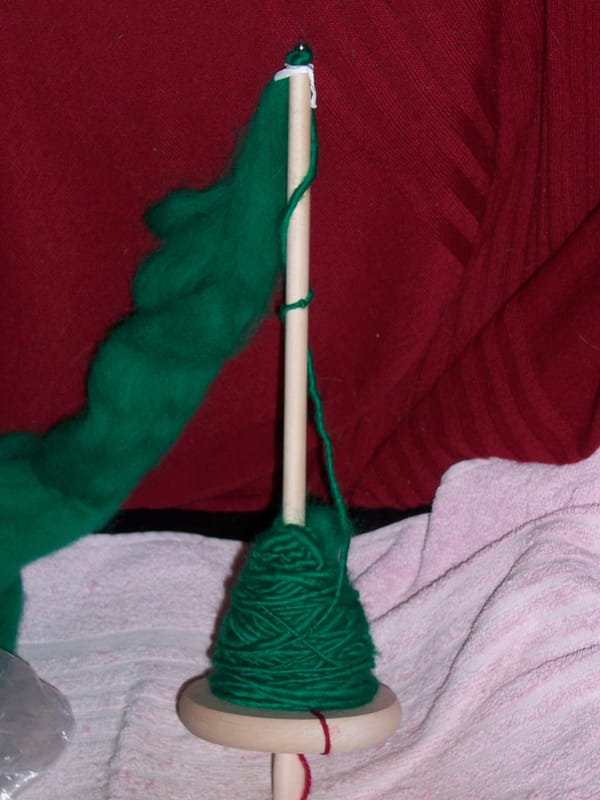I put my hand to the latch

There's only one thing I don't like about latch hook rugmaking, and that's the fact that you can, after all, use only so many rugs; and, these days, I can't use rugs at all, or at least not the thick and luxurious ones you get from latch hooking. They're too much of a nuisance with the Zimmer frame. I have a couple of flatter and more utilitarian rugs from IKEA which serve that purpose. So I either have to give them away (which I've done a few times; in particular, my sister has one with autumn leaves on a black background, which she likes very much, not least because it is easy to wash when the cat is sick on it) or find some other use for them. This one, as you see, goes on the wall. I've always loved poppies, so I'm very fond of it. I also made a round one with a black background, bought some black hessian and a huge quantity of those little expanded polystyrene beans, and made a beanbag pouffe. I can't sit on it myself (I need something I can push myself up from), but other people can.
Latch hooking is not a difficult craft. You have a latch hook which looks something like this:

This one has a wooden handle, and if you plan to do a lot of latch hooking it is worth getting something similar; latch hook kits frequently include a cheap and cheerful one with a plastic handle, which will do the job, but is not very comfortable for extended use. As you see, the hook is fixed, while the latch is free to swing. The actual technique is explained simply and briefly here, or, as ever, there is a wide choice of videos available for those who prefer that sort of thing. (Finding written instructions for crafts online is always harder than finding videos, which is one of the two reasons I'll do the hard work for you on that one; the other one is that I much prefer text to video myself.)
If you're taking up the craft for the first time, it's best to start with a small piece, like a cushion. Large pieces are no more difficult, but they can be very awkward to handle, and if you don't have arms like a gorilla you will need to roll them up as you work. The canvas usually comes printed with a grid, which is very helpful for keeping track of where you are; you can get blank latch hook canvas, but since the grid is entirely hidden by the finished design, there's really no point.
There is a great deal of similarity between latch hooking and cross stitch; in particular, if you have a chart that works for one, then it also works for the other (within certain limits described below), which means that you can make a square (or approximately square) rug and then cross-stitch a couple of matching cushions, if you're so inclined. However, the way the supplies are packaged does differ somewhat. You can certainly get cross stitch kits, but it's somewhat more common to buy a chart and then get the rest of your supplies separately. With latch hooking, on the other hand, it's much more common to use a kit. You can buy both the canvas and the yarn separately (yarn sold specifically for latch hooking comes in short pre-cut lengths about 6 cm long, but if you have the patience there's nothing to stop you buying balls of chunky yarn and cutting it to length yourself), but I don't think I've ever seen a chart primarily intended for latch hook sold on its own. Of course, you can always use a cross stitch chart; but you will probably have to adapt it. The range of colours available in latch hook yarn is nowhere near as extensive as that available in stranded cotton for cross stitch, and therefore you will either need to choose a design with few colours or be prepared to combine some of the more similar ones. It is also best to avoid either very large charts (you will, after all, want to be able to fit your rug into your living room!) or charts with a lot of fussy detail, which is inclined to get blurred in latch hooking.
Some latch hook designs are shaped. I did one for my nephew in the shape of a teddy bear, and of course there was the round one I mentioned earlier. This is possible because the canvas doesn't fray; however, if you work one of these you will still have to bind the edge in some way, or you will get unsightly little bits sticking out that may catch on things. Depending on the type of canvas, and the use to which the design is to be put, you may get away with using ordinary bias binding; but it is possible to get specialist rug binding, and if you are going to put the rug on the floor I strongly recommend using that, as it is very hard-wearing. It is best to do the binding before you work the design, rather than after. (I bind all my latch hook designs, even the ones with straight edges. It just ensures that everything is absolutely neat.)
Some latch hook kits come with the design pre-printed on the canvas; some provide a chart; but it is quite common to find you have both. Printing on latch hook canvas, after all, is never exact, because it has to be aligned very precisely with the threads and that is not always possible. If the canvas is printed, it is a helpful guide, but the chart should usually have the last word if there is any doubt. The only exceptions occur at the edges of a shaped design, where there may be a hole or two more or fewer than you would expect due to slight inaccuracies in cutting and/or printing. (This is particularly the case for sloping edges, where the cutting line goes through some of the holes at an angle.) It's never a problem. At the edges you're invariably using the background colour anyway.
Latch hook kits can be expensive; if you want one that is reasonably cheap but still good quality, go to eBay, but be prepared to find that all the instructions are in Chinese! (You may also get a little bit of hilariously badly translated English. This is fine. You can easily find instructions if you're stuck.)
Finally, a word about care and maintenance. You can get latch hook kits which use pure wool, and these are naturally going to produce very hard-wearing results; but I've never used one, so I can't tell you how to look after them. I can, however, tell you about acrylic rugs. If you put them on the floor, it is possible to vacuum them with care, and they will also benefit from having the dust beaten out of them regularly; however, they will also need to be washed from time to time, because they do get grubby (irrespective of any nauseous felines in the vicinity). Fortunately they wash perfectly well in the machine. I would personally not be inclined to tumble-dry them, and I would also hang them over a line rather than trying to peg them, which would crimp the yarn. Wall hangings will probably never need washing, but, again, do beat the dust out of them now and again. It's surprising how much of it builds up.
All this is making me want to get out my latch hook again... but... what on earth have I got room for in here?




